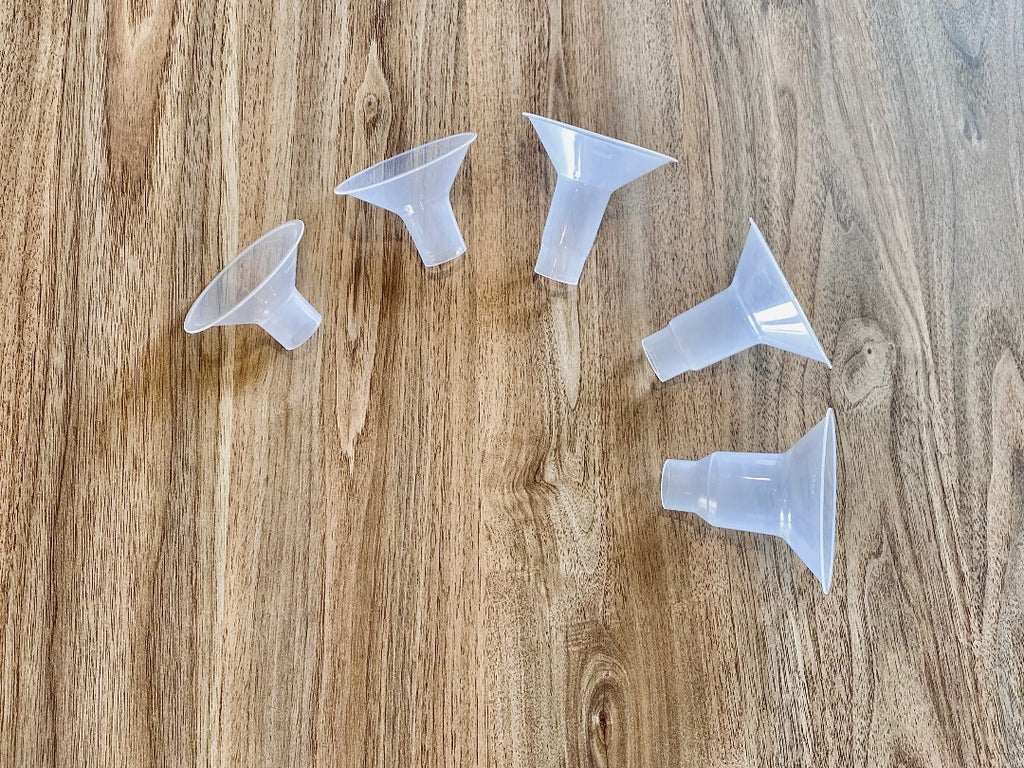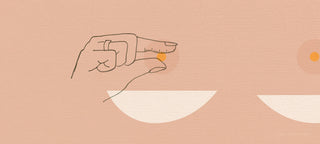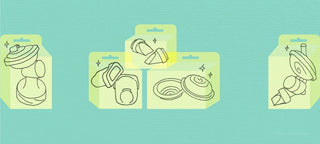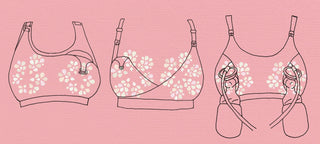A breast pump - however fabulous! – is only as good as its fit.
Skip the intro, I want the info
My daughter was 7 months old when I returned to work a few days a week. Call me cavalier, but it was only on the first morning I started back that I even unboxed the breast pump my girlfriend had gifted me at my baby shower. I had struggled through a painful shallow latch to establish breastfeeding and though I was lucky to enjoy a good supply of milk (some of which I had stored already), I had no real conception of what pumping should feel like. So I sterilised and assembled everything, popped it in my bra at morning tea and crossed my fingers.
I was full to the brim with milk when I turned on my pump, so the feeling of relief outweighed the obvious discomfort of the pumping. I ignored the signs that seem so undeniable in retrospect – my nipples often seemed to double in size, there would be dark pressure rings around the areola and I found myself using only the higher suction levels of the (very powerful) pump. I figured this was what pumping was, and my underwhelming experience of support from the midwives in hospital had closed my mind off to seeking any further advice. I was happy filling bottles and thought no more of it until I returned to pumping after my maternity leave with baby number two.
Thankfully, along with my new baby, I had gained a new awareness of the importance of correct breast pump flange sizing after joining the Youha Australia team. As soon as I started using the correct size flange inserts, I was blown away by the improvement. I no longer felt any pain while pumping, it felt much more like my son breastfeeding (without the ever-present threat of razor-sharp baby teeth!), there was no pressure ring around my areola, and no nipple swelling. I also found I could express more quickly and with the lower suction levels on my pump, which saved battery and was much quieter.
About six months after my son was born, my cousin gave birth to a baby boy who was unable to latch right away and, determined to breastfeed, she found herself thrust into the world of EBM (expressed breast milk) and exclusive pumping. I hoped she had received the right sizing advice but learned that she too had started using her pump right out of the box (8 times a day!) with no real consideration for size. I gifted her some sizing convertors and breast pump cushions and proceeded to receive a flurry of texts gushing about how much of a difference they'd made for both her comfort and output.
How many more pumpers out there are using the wrong flange size? Are you? Are any of those you care about?

We can make fabulous breast pumps, but no pump manufacturer can account for everyone's sizing straight out of the box. So, here we're going to break down everything you need to know about how to refine the fit of your breast pump flange sizing. Use the tips below – developed with the generous expertise of Youha in-house International Board Certified Lactation Consultant (IBCLC) Kate – to make sure your pump is as comfortable and effective as it can be.
Hold up, what's a flange?
A breast pump flange is the pump part that sits against your breast and looks like a funnel. In most traditional direct-to-bottle breast pumps, the flange is made of hard plastic like these ones:

In the newer hands-free pumping cups and wearable pumps the flange is made of soft silicone, like this:

The term flange and breast shield are used interchangeably.
What is flange size?
The flange size refers to the internal width of the tunnel in your breast pump flange or flange insert (also known as a convertor). The key connection point between your body and your pump, this tunnel is where your nipple is drawn into to express milk.
So, why does flange size matter?
Breast pump flange sizing matters because, frankly, your comfort matters. And, when it comes to pumping, your comfort (among other benefits) is largely driven by how well your nipple fits into your breast pump's flange. Pumping pain and discomfort is not, as I had mistakenly believed, the price you have to pay to mine your most precious resource, breast milk. With the correct flange fit, you can be more comfortable, express breast milk more effectively, prevent nipple damage and be less likely to cut your breastfeeding journey short.

IBCLC Kate had these points to note about breast pump flange sizing:
How to know when the flange fit is too large
- nipples are stretchy! If the flange size is too large your nipple will swell in size, and when you remove the pump you will notice your nipple is wider as well as longer
- your milk output can be reduced as there is less stimulation to the nipple
- the large fit may cause damage and pain to the nipple as it is moving too much within the flange.
What happens when the fit is too small
- the nipple will struggle to move within the flange, reducing the milk output
- you may experience pinching and friction on the nipple
- the too-tight fit may cause damage to the nipple
What the ideal flange fit should look and feel like
- your nipple should glide through the tunnel, touching the sides is ok – although previously this was thought to be too small of a fit*
- only the nipple is pulled into the tunnel, no areola or breast tissue goes in
- your milk sprays from the nipple during pumping
- Pumping should feel like nothing or a gentle tug. Woo!

*Advice is changing in this space. You might have been told that your nipple should be able to move freely within the tunnel of the flange, however the issue with having too much room to move is that often the areola is being dragged into the tunnel –ouch!– so the suction is less concentrated where it is needed, and instead causes the nipple (an elastic tissue) to swell. Pumpers have reported greater comfort and improved milk output when the nipple is just touching the sides of the tunnel.
How to measure your flange size
- do not pump prior to measuring
- stimulate flat or inverted nipples briefly with your fingers to bring them out
- measure across the base of your nipple only ensuring you are not measuring any of your areola. You can measure using a ruler, circular tool, or a tape measure. You may also take note of the size of the tip of your nipple, if there is a large size difference between the tip and base you may be best to try the size for both to find the most comfortable fit
- Ideally your flange size will be very close to your nipple measurement up to 2mm larger but no more to prevent swelling of the nipple
- Measure both your left and right nipples as it's common for them to be different
What to do if you need to change your flange size
If you need to use a size different from the standard sizing supplied with your pump:
- Ideally, source the correct sized hard plastic flange or silicone breast shield if your size is available.
- If needed, use a silicone flange insert to decrease the size of your flange by pushing it all the way in so the skirt sits flush against the flange - this is easier to achieve once the rest of the pump has been assembled. Note: you'll still need to pull the insert out of the flange for cleaning and sterilisation.
-
Additionally, a silicone breast pump cushion (like the one shown fitted over the pump flange below) can increase comfort when used with the correct size flange.

Kate cautions:
- Wearable pumps: Flange size is even more important for the efficiency of your wearable pump than in a traditional direct-to-bottle style pump, so take the time to get it right if you want to maximise your milk output.
- Milk output won't always change: Those with an abundant supply of milk might not see an increase in milk output like others would expect to when correcting their flange size, but they will still enjoy significantly improved comfort.
- Elastic nipples: All nipples are stretchy, however those who experience greater elasticity (what's referred to as "elastic nipples") might find they need to do some more testing than others –with the following advice in mind– to help refine their fit:
- first select the smallest flange size that feels comfortable (a size that is too large will make it easier for elastic nipples to swell and stretch)
- go up a size if you notice any signs of pinching (change in nipple colour or pinching sensation)
- consider using a breast pump cushion to hold back the areola and prevent it from being pulled in and stretching.
Wrap-up: Why Breast Pump Flange Sizing Matters

As new parents we can tend to put the needs of our family before our own, but there's no need to make yourself a pumping martyr like I did! Breast pumps are designed to provide us relief and convenience, and when sized correctly they do just that, without any pain or discomfort. So grab a ruler and check your fit with our breast pump flange sizing guide below, because you deserve to enjoy using your pump and the power it can give you to take control of your breastfeeding journey.
Use the share button and share this blog to shine a light on the importance of breast pump flange sizing and remind all the other pumpers in your life that their comfort is EVERYTHING when it comes to pumping.

Thanks for your advice Kate!
Our in-house expert Kate is a Registered Nurse and International Board Certified Lactation Consultant with over 8 years of experience in both Community Paediatric and Neonatal Nursing (damn, girl!)
Kate is working with Youha in our joint aim to educate, empower and support you to meet your pumping/feeding goals.
You can view Kate's Bio in our Expert Directory to learn more.
Just a friendly reminder that this blog provides general information and is not intended and should not be considered, nor used as a substitute for, medical advice, diagnosis or treatment. If in doubt, please always consult your healthcare professional.




